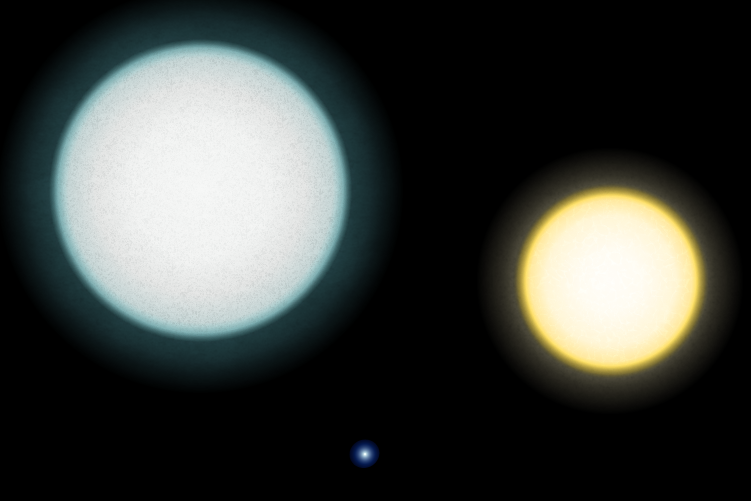J-PLUS observational constrains to the white dwarf spectral evolution

White dwarfs are the degenerate remnant of stars with masses lower than 10 times that of the Sun and the endpoint of stellar evolution for more than 97% of Galactic stars. White dwarfs are an important tool in studying the star formation history of the Milky Way, the late phases of stellar evolution, and to improve the physical knowledge about condensed matter.
No fusion reactions take place at the heart of a white dwarf. The only thing able to provide an outward force large enough to balance the star’s own huge weight star’s is the pressure of their electrons when trying to avoid, as the Pauli principle dictates, to occupy the same quantum state. In a white dwarf, this pressure is enough to prevent it from collapsing further into a singularity, although their density is enormous: when our Sun dies, the size of the resulting white dwarf will be that of Earth. White dwarfs consist of helium nuclei (and carbon and oxygen nuclei in the more massive cases) and a degenerate gas of electrons.
The surface of white dwarfs gradually cools down from temperatures as high as 100,000 K, producing enough ultraviolet radiation to ionize their surrounding nebula, making it visible for around ten thousand years, until it is diluted into the interstellar medium. The definition of photometric white dwarf catalogues is mainly based on the search of these ultraviolet-excess objects. The technical limitations of the first photometric and spectroscopic catalogues were improved thanks to the Gaia mission. This mission provides a unique source of astrometric and photometric information to define the largest and more secure white dwarf catalogues up to date, with 360,000 sources so far (GF21).
The spectroscopic analysis of the early white dwarf catalogues demonstrated their spectral diversity. Those white dwarfs with hydrogen lines in the spectra are classified as DA type, while those presenting helium absorption can be DO (He II) or DB (He I). Featureless spectra in the optical define the continuum DC class, while the presence of heavy metals polluting the white dwarf atmosphere lead to the DZ and DQ (carbon) classifications. Hybrid types have also been reported.

The dominant atmospheric composition of white dwarfs, defined as H-dominated or He-dominated depending on the most common component in their outer atmosphere, changes with cooling age. The change in the fraction of He-dominated atmospheres in white dwarfs at temperatures below 25,000 K, the so-called spectral evolution, has been interpreted as the effect of convective dilution and convective mixing processes, where the outer hydrogen layer and the underlying helium layer in white dwarfs are mixed due to the appearance of convection zones. If this is so, detailed knowledge in the white dwarf spectral evolution provides clues about the physical processes acting in white dwarfs as they cool with time.
Unfortunately, the current photometric data from the Gaia early data release three (EDR3) does not permit a spectral classification of the white dwarfs, preventing the study of their spectral evolution along the full sky.
Now, a team of researchers has used 1 Javalambre-Photometric Local Universe Survey (J-PLUS) second data release (DR2) along 2,176 deg2 to supplement the GF21 catalogue, based on Gaia EDR3, and provide observational constrains to the white dwarf spectral evolution between 5 000 and 30 000 K. J-PLUS is an unprecedented photometric sky survey of 8500 deg2 visible from Javalambre (Aragón, Spain), using a set of 12 broad, intermediate and narrowband filters.
The researchers analysed a sample of 5,926 white dwarfs in common between the GF21 catalogue and J-PLUS DR2. They estimated the effective temperature, surface gravity, parallax, and atmospheric composition (H-dominated or He-dominated) of the sources with a Bayesian analysis, and found that the fraction of He-dominated white dwarfs increases by 21 % from 20,000 K to 5,000 K. This fraction of He-dominated white dwarfs can be adjusted with a linear function of the effective temperature.
This work provides hints about the capabilities of low spectral resolution data in the study of the white dwarf population.
Author: César Tomé López is a science writer and the editor of Mapping Ignorance
Disclaimer: Parts of this article may have been copied verbatim or almost verbatim from the referenced research paper/s.
References
- C. López-Sanjuan, P.-E. Tremblay, A. Ederoclite, H. Vázquez Ramió, J. M. Carrasco, J. Varela, A. J. Cenarro, A. Marín-Franch, T. Civera, S. Daflon, B. T. Gänsicke, N. P. Gentile Fusillo, F. M. Jiménez-Esteban, J. Alcaniz, R. E. Angulo, D. Cristóbal-Hornillos, R. A. Dupke, C. Hernández-Monteagudo, M. Moles and L. Sodré Jr (2022) J-PLUS: Spectral evolution of white dwarfs by PDF analysis Astronomy & Astrophysics doi: 10.1051/0004-6361/202141746 ↩